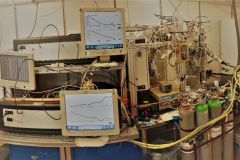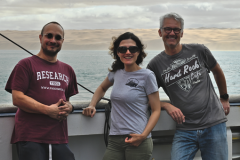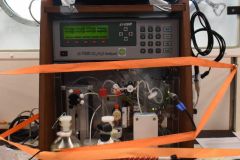
The Benguela System under climate change - Effects of Variability in physical forcing on carbon and oxygen budgets
06.02. - 07.02.2022 – It's slowly going back again
The work on the southernmost transect has been completed and before we enter the harbour of Walvis Bay in a few days, we want to go back to some stations on the 25°S latitude that were interesting for our work and do some more sampling.
The marine biogeochemists of the Trace Gas Biogeochemistry group, led by Prof. Dr. Gregor Rehder, investigate how the complex network of physical drivers, geochemical processes and microbial activities has impact on the release of climate active gases such as carbon dioxide, methane and nitrous oxide in the course of climate change in the Benguela upwelling system as part of the EVAR project. As soon as the ship left Walvis Bay in the morning of 11 January, the mission of the trace gas group started by getting the mobile equilibrator sensor system (MESS in short, sometimes well-deserved name as it becomes a mess  ) into action for on-the-go measurements of the gases in the surface water and occasionally, in the atmosphere. But they were lucky enough as the MESS system has been working faultlessly (that is, which issues that could be fixed) so far, which brought satisfaction and smile to the group’s faces.
) into action for on-the-go measurements of the gases in the surface water and occasionally, in the atmosphere. But they were lucky enough as the MESS system has been working faultlessly (that is, which issues that could be fixed) so far, which brought satisfaction and smile to the group’s faces.
In order to have better understanding of the gas dynamics in the Benguela upwelling system, they also sample the water column from surface to depth in proposed stations for the gas measurements later at IOW, to discover the underlying pattern of the gases. To get a grip on the carbonate system in the upwelling system, they measure dissolved inorganic carbon (DIC) and seawater pH, both important parameters for the inorganic carbon system, for the former using the Automated Infra-Red Inorganic Carbon Analyzer (AIRICA). Being amongst the first to gather data from the cruise, the trace gas group will also be the “last team standing”, as the surface measurements are continued on the transit from the working area off Namibia towards shortly before entering the Economic Zone (EEZ) of Cape Verde covering almost 40° of latitude and passing the equator. Chapeau! (Text: Bita Sabbaghzadeh)
Text: Fabian J., Braun P. (both IOW)
| Expedition: | MSM105 |
| Mission: | BUSUC 2 |
| Start: | 11.01.2022 - Walvis Bay |
| Ziel: | 23.03.2022 - Mindelo |


